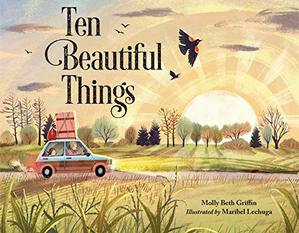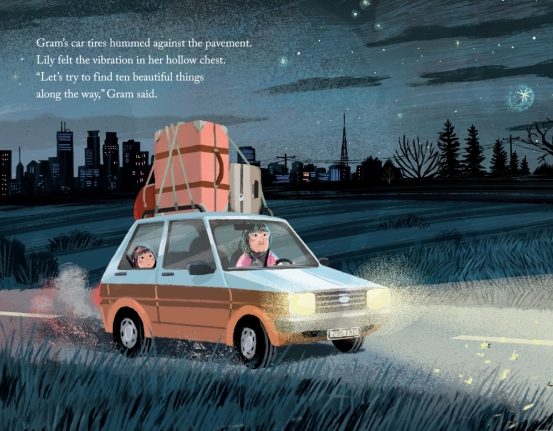 Ten Beautiful Things
Ten Beautiful Things
Author: Molly Beth Griffin
Illustrator: Maribel Lechuga
Charlesbridge
12 January 2021
32 pages
This month’s PB review is by Ryan G. Van Cleave (Picture Book Reader Aficionado at Only Picture Books) and Ringling College of Art and Design Illustration Professor (and OPB friend) Rebecca Zomchek.
–Ryan’s Review of the Writing–
Moving to a new home is on the short list of Most Stressful Things a child can go through, and that’s what’s happening with our main character, Lily. The story begins with Gram driving Lily to a far-off Iowa farmhouse–the child’s new home.
We quickly realize that Lily is going through yet another Most Stressful Thing. Her parents are MIA. It’s never explained why they’re not in the book, but the reasons surely don’t matter. The mere fact of their absence exponentially adds to Lily’s sadness and anxiety.
To pass the time–and take Lily’s mind off her worries–Gram suggests, “Let’s try to find ten beautiful things along the way.”

Lily is understandably reluctant. But, soon, she notices how beautiful things start to appear once you begin to look for them.
A gorgeous sunset.
A wind farm whose “spinning windmill blades gleamed in the morning sun.”
“A red-winged blackbird perched on a swaying stalk of last year’s corn.”
What makes things interesting and situationally honest is that between these moments where Lily witnesses beautiful things–all wonderfully depicted by the skilled hands of Maribel Lechuga–she slips back to feeling sad and “hollow” inside. The contrast of Lily being gently urged out of her funk by these beautiful moments is well handled, and the more beautiful moments she finds, the less fully and frequently Lily slips back into that place of sadness.
Beauty seems to resurrect her dampened spirits and fortify her. What a lovely idea.
At one point, Gram suggests that a falling-apart barn counts as a beautiful thing, yet Lily disagrees because it’s not pretty. Gram responds: “We’re not looking for pretty. We want beautiful.” What a great distinction–pretty versus beautiful. I can see how adult readers might have a conversation with a child over what those words mean and why considering their differences is worthwhile.
Without giving spoilers, the resolution to the hollow feeling inside Lily’s chest and the arrival of beautiful thing #10 are emotionally rewarding and earned by the story. I’m also pleased that the author avoided naming most of the emotions, choosing instead to let art, action, and nuanced dialogue bring those to life for readers. Trust me–they’ll get it.
In Ten Beautiful Things, Molly Beth Griffin has created a touching, quiet book that’s both a nod to the wonders of the natural world and a positive life-changing journey for a child who has brighter days ahead.
4.75 out of 5 pencils
– Rebecca’s Review of the Illustrations–
This book is a visual pleasure and really is full of many beautiful things.
We are presented with a wonderful diversity of times of day, landscapes, and weather, and through these different vistas, the book does a brilliant job of taking us on this journey of not only passing from city into country, but finding our way home.
As someone who grew up in the Midwest and has gone on many meditative car trips, this book was wonderfully nostalgic and felt like such a real time and space come to life on the page. From the rolling fields, to hay bales, to the wind turbines and glowing treetops at sunrise, the land springs to life for us as the day unfolds and invites us along on the visual and emotional journey Lily and Gram are experiencing.
Illustrator Maribel Lechuga has really taken advantage of digital painting’s capacity for texture and has included wonderful movement and light. The clouds swirl and undulate, grass and water flow, and both leaves and birds float in the breeze. Along with our vibrant landscapes, we get wonderful 360° views around the car, both inside and outside, which help to capture the feeling of movement and the inner and outer worlds of a person.
One of my favorite scenes is the rainstorm as Gram and Lily get close to their final destination. The storm is palpable and generates a sense of drama, energy, and cleansing. This moment also creates closeness between the characters, and I found myself drawn into every page, looking at all of the small details and finding beauty in the pebbles and fences and treetops as I remembered so clearly and fondly the places where I grew up.
Lechuga captures emotion even with a relatively simplified character design style. We can feel loss, longing, questioning, and even grief on the characters’ faces (especially Lily’s), but also toward the end of the book we can feel the peace, growth, and love between the two characters as they find beauty together through hard times.
For a book that covers a lot of intense emotions that are not necessarily given names in the text, the illustrations do a fantastic job of drawing us all in and connecting us to the journey–both physical and emotional–that the characters are taking. At the end of the book I, too, was pleased with all the beautiful things I found and felt as I enjoyed this story.
5 out of 5 crayons
 Rebecca Zomchek is a children’s book illustrator who has worked as a concept artist and cartoonist. She earned her BFA from Syracuse University and her MFA from The School of Visual Arts; she teaches Illustration at Ringling College of Art and Design. Rebecca likes distinguished things like classical music and museums, but also loves being outside and getting paint everywhere.
Rebecca Zomchek is a children’s book illustrator who has worked as a concept artist and cartoonist. She earned her BFA from Syracuse University and her MFA from The School of Visual Arts; she teaches Illustration at Ringling College of Art and Design. Rebecca likes distinguished things like classical music and museums, but also loves being outside and getting paint everywhere.
